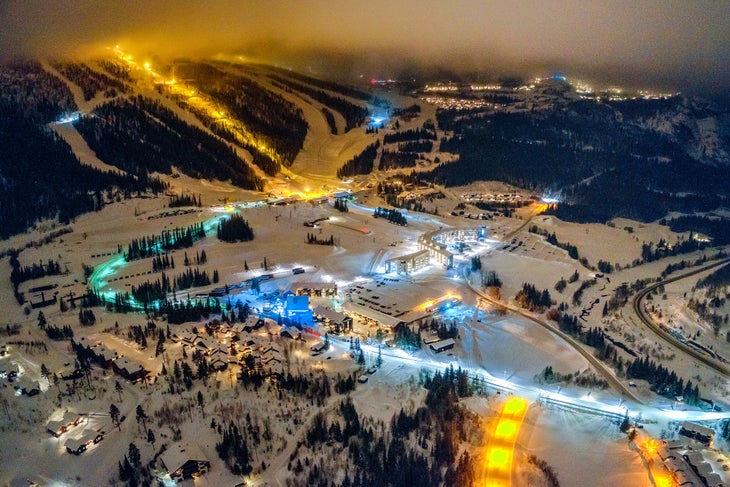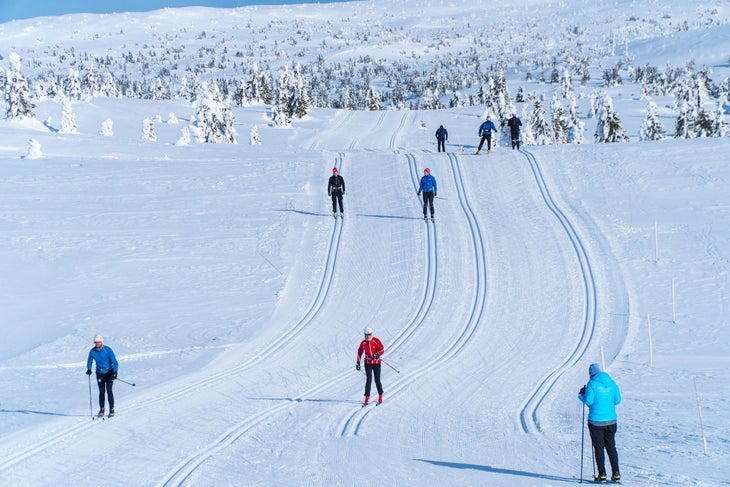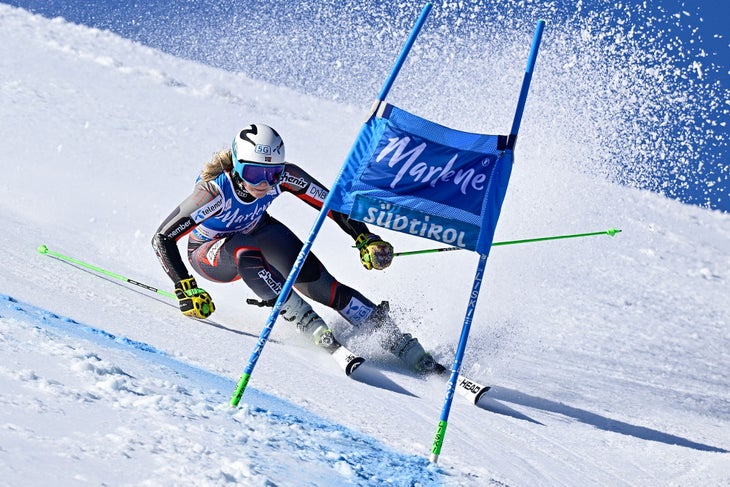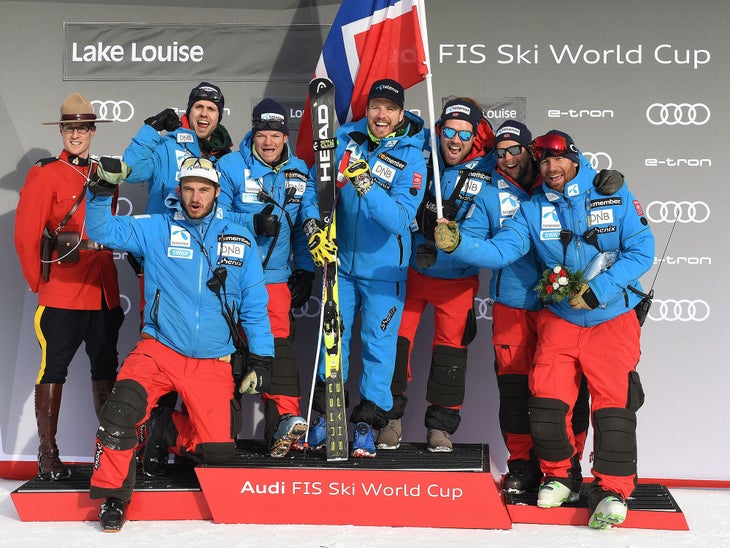Products You May Like
Tune into SKI’s Olympics homepage to stay up to date on all the stories and latest news from Beijing.
North of Oslo, Norway, in the birch and pine-laden Nordmarka forest, there are miles and miles of trails, and occasional hyttes, or cabins, where hikers, cross-country skiers, or snowshoers can eat homemade pastries, heart-shaped vaflers, or drink a bottle of refreshing Ringnes Pilsner. Ski resorts and ski jumps are connected by public transportation, and no one bats an eye if you bring your skis on the train. The country, home to roughly 5 million people, has a culture that values a life outdoors.
Norwegians of all ages in this heavily forested and mountainous area of northern Europe believe in the concept of friluftsliv, coined in the 1800s by Norwegian playwright Henrik Ibsen, which means living a free life in nature. Ibsen believed that a connection to nature resulted in mental wellbeing, and this sentiment is manifested today in the art of embracing outdoor activities. In the summer months, when the sun seemingly never sets, outdoor life can be easy to embrace. But in winter, when daylight is fleeting, connecting to nature takes motivation, passion, and an infrastructure that caters to winter-time activities.

“Norwegians are very active and they love sport and love to be outdoors—it’s in their blood,” says Felix McGrath, who splits his time between Norway and the U.S., where he is currently the Sport Director at Burke Mountain Academy in Vermont. A U.S. Ski Team alumni, McGrath married a Norwegian cross-country racer and moved to Norway, where he ran a successful ski racing program and eventually became the head coach for the Norwegian women’s alpine ski team. His son, Atle Lie McGrath, currently skis for the Norwegian men’s alpine team.
Related: U.S. Ski Team names the ski racers headed to the 2022 Beijing Olympics
McGrath’s experience gives him a unique lens in which to view Norwegian winter sports culture. Norwegians are dominant on the world stage in winter sports, leading the world in cross-country skiing, and in fact, Norwegian athletes have won 371 medals since 1924, when the first Winter Olympics were held in Chamonix, France.
The alpine ski racers are dominant in their own right: Retired racer Kjetil Andre Aamodt has the distinction of being the most decorated Norwegian Winter Olympic athlete, with a staggering eight medals to his name, and retired great Aksel Lund Svindal is considered one of the best ski racers to hail from Norway of all time. Current Norwegian national team member Aleksander Aamodt Kilde, with 27 World Cup podiums and 12 victories under his belt, is another of Norway’s ski racing heroes. And let’s not forget about Kjetil Jansrud, a four-time Olympic medal winner, who has miraculously recovered from an injury sustained in the 2021 Beaver Creek Birds of Prey race and will stage a comeback just in time to compete in his sixth Winter Olympics.
Related: Olympic medal contender Breezy Johnson withdraws from Beijing Games due to injury
Aside from its northern location, how does a country roughly the size of New Mexico produce so many great winter sports champions, particularly in skiing?
“It’s about ‘ski for life,’ in Norway. Whether you’re a Nordic skier or alpine skier, a very large portion of the population skis,” says McGrath. “You forget that it’s so dark in the winter because everything is lit up and skiing is accessible since Norwegians prioritize these types of opportunities.”

In Norway, it’s common for parents to put their children on cross-country skis as soon as they can toddle. Most kids join local ski programs where the focus is on having fun, without worrying about results. Additionally, the coaching competence and skill level is high, thanks to a plethora of engaged parents who are themselves former ski racers. “My wife is a big Nordic skier and had both our boys Nordic skiing at age two,” says McGrath. “That was part of the lifestyle. When Atle turned 8, I took him to the local hill in Oslo to check out ski racing. He loved it. He had gained so much good experience from being on Nordic skis for years, night after night, that he was incredibly balanced on alpine skis.”
The Norwegian alpine ski team has captured a lot of attention lately, and not just for the impressive number of podiums and medals. It’s for the literal way they interpret the saying, “there is no ‘I’ in team.” Unlike the American super sports star who travels with his or her own entourage and coach, like the staff who make up “Team Shiffrin,” Norwegian athletes operate with egalitarianism, where no athlete—not a decorated medalist or a rookie—is above another or treated as such, and teammates are encouraged to help develop each other’s skiing.
“For us, it’s a team culture that we ourselves make, and it’s not forced on us in any way,” says Ragnhild Mowinckel, Norwegian women’s alpine ski team member and Olympic silver medalist in both GS and downhill in Pyeongchang. “We are all invested in each other’s career and feel supported by each other. Often, a comment from a fellow racer means more to me than one from a coach.” By helping others, she explains, everyone on the team also helps themselves because that common mentality increases the quality of training for the whole team. “It doesn’t make any difference if you are the best or slowest person, your voice is heard and valued the same.”

This team philosophy, where every voice is valued, is the social fabric surrounding the athletes and coaching staff, and it reflects Norwegian cultural beliefs in personal accountability combined with social equality. According to the Democracy Index, Norway was awarded the title of most democratic country in 2020, (in terms of political participation, civil liberties, and the electoral process), and every citizen has access to healthcare, free education, and social safety nets. Other teams around the world do not share this same philosophy in terms of seeing everyone as equal, and instead foster competition among teammates through a social hierarchy. “That came to my attention when we saw how many different teams there are within the same nation, and they might not even train together,” says Mowinckel. “It’s very strange for us. It’s dangerous to think you become the best one all by yourself.”
During the 2022 Winter Olympics, Norwegian teammates will rely on the relationships they have fostered with their peers. Ski racers will inspect the courses together, share ideas on tactics, and relay course reports to each other. They’ll share evening meals and play board games to relax. “They really trust each other and that’s an important part of their teamwork,” says Norwegian men’s speed team coach, Peter Anderson. Anderson, an American and former U.S. Ski Team men’s coach, says that when comparing technical skills, the U.S. and Norwegian athletes are working on similar things. In fact, the two nations have a partnership in training and work together at races. But he acknowledges that the Norwegians have a unique team culture, and it motivates him to be a better coach.

“I’ve heard Jansrud say, ‘ski racing is an individual sport, but at the end of the day, only one guy can win, and it lasts for a few minutes. The other 23 hours of the day, you live together, work out together and help each other to be the best.’ That kind of theme makes the success of your peers even better. For 9 months of the year, we’re this family who thrives together to be fast as individuals.”
The Attacking Vikings, as they’re called, don’t attribute any secret to their success in terms of technique or tactics on the hill. To them it’s very simple: Share your knowledge and lift up everyone on the team.“What I saw in Norway at the youngest level is that each kid individually takes ownership, but when the group does it collectively, they all reap the benefits,” says McGrath. “After several years in Norway, I started to change my own philosophy.”
The opportunities to recreate are everywhere in Norway, as McGrath experienced, and parents pass down their winter sports passion to their offspring. Kids grow up having fun on the snow, day and night, in programs or with family and friends. This community aspect—whether in competitive skiing or simply enjoying the outdoors—provides Norwegians with a positive environment in which to grow up and delight in friluftsliv. “We only get stronger and faster by helping each other out,” says Mowinckel. “Some qualities aren’t measured in results.”
